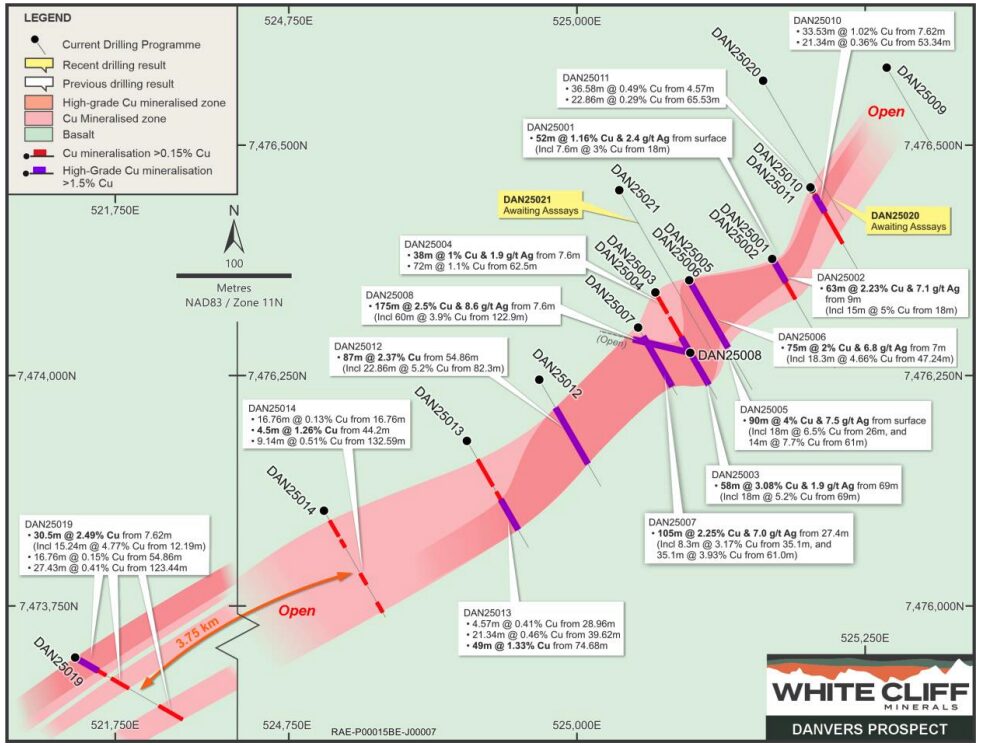White Cliff Minerals increases scale of Danvers ahead of maiden copper resource

Digitisation work and magnetics from an aerial survey indicate the potential for a 4km-long mineralised structure at the Rae copper project. Pic: Getty Images
- White Cliff Minerals doubles strike length at Danvers 1 after digitising historical data
- The results show thicker and higher-grade zones within a system previously modelled at a 2% copper cut off
- Upcoming aerial EM results combined with the digitisation will refine targets ahead of a maiden resource in 2026
Special report: White Cliff Minerals has increased the scale of the Danvers 1 area within the Rae copper asset in Nunavut, Canada, after completing the digitisation and review of historical drilling and surface data.
This work marks a major technical milestone upgrading White Cliff Minerals’ (ASX:WCN) geological understanding and confidence at Rae.
Perth-based Terra Resources assisted with the detailed review, combining digitised historical and current drilling with on-ground validation of collar locations.
The result is a significantly more accurate 3D model that has directly contributed to expanding the known copper footprint at Danvers.
This new interpretation shows a substantial increase in scale.
Drilling has more than doubled the mineralised strike length to more than 950m, up around 153% and confirmed continuity of copper mineralisation beyond 400m depth.
Modelling also highlights thicker and higher-grade copper zones than previously recognised – within a system historically constrained by a high 2% copper cut off, pointing to meaningful upside ahead of resource definition work.

“Exceeded expectations”
Managing director Troy Whittaker said the results continued to underpin the company’s dual-pronged strategy of expanding the Danvers discovery while simultaneously advancing exploration for sedimentary targets.
“Results from our maiden drilling campaign at Danvers have exceeded expectations and represent a pivotal step forward in redefining the scale and quality potential of this asset,” he said.
“When we acquired the Danvers Project in November 2024, we recognised its strong foundations, which included a historic estimate of 4.16Mt at 2.96% copper over a 375-metre strike, open in all directions.
“Since then, through diligent digitisation, detailed fieldwork and targeted drilling, we’ve significantly expanded both confidence and footprint, extending the mineralised strike to more than 950 metres – a >150% increase over the previous estimate.
“Mineralisation has also now been confirmed beyond 400 metres depth, reinforcing the strong continuity of copper sulphides at depth.”
Digitisation clarifies Danvers scale
Since taking ownership, White Cliff has been running detailed digitisation and validation work in parallel with a successful maiden drilling campaign.
By georeferencing historical maps and re-surveying collar positions in the field, the company has accurately reconstructed drilling completed in the 1960s – work that until now had only existed in partial paper records.
That digitised dataset can now be integrated with the 2025 drilling from White Cliff and the 2003–2005 drilling completed by Coronation Minerals, allowing for a much clearer view of the copper system at Danvers.
Watch: White Cliff locks in final piece of the puzzle with new acquisition
Work to underpin maiden resource
A recent airborne survey has opened the door to even greater regional potential at Rae, identifying multiple high-priority targets along a 10km stretch of the Teshierpi Fault Zone – the same structure that hosts the Danvers 1 copper system.
These newly defined targets represent areas that had not previously been explored and point to meaningful upside beyond the existing mineralisation footprint.
Adding to this momentum, White Cliff has confirmed a second discovery within the same structural corridor.
At Danvers 2, several kilometres along trend from Danvers 1, shallow, high-grade copper has been revealed that reinforces the scale and continuity of the broader system.
Drill hole DAN25019, more than 4km northeast of Danvers 1, returned 15m at 4.8% copper and 20g/t silver from just 12m, confirming the presence of a second mineralised centre.
Together, these results demonstrate that the Teshierpi Fault Zone has the potential to host multiple copper deposits.
Upcoming aerial EM results, integrated with the digitised drilling data, will sharpen targeting for the next drill program along the 10km Teshierpi Fault Zone, and underpin progress towards a maiden JORC resource in 2026.
This article was developed in collaboration with White Cliff Minerals, a Stockhead advertiser at the time of publishing.
This article does not constitute financial product advice. You should consider obtaining independent advice before making any financial decisions.
Related Topics

UNLOCK INSIGHTS
Discover the untold stories of emerging ASX stocks.
Daily news and expert analysis, it's free to subscribe.
By proceeding, you confirm you understand that we handle personal information in accordance with our Privacy Policy.








